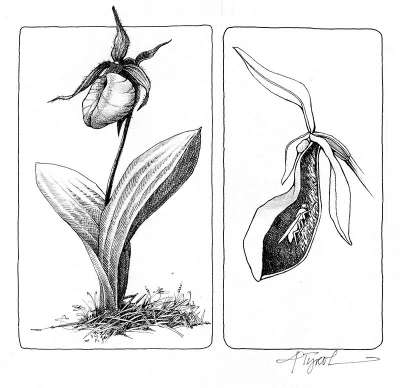
I’ll never forget my first encounter with lady’s slippers. While hiking the Long Trail in southern Vermont one June, we camped near a remote pond. Our tent site beneath an evergreen canopy was surrounded by the flowers. Each hung from a stalk that arose from a pair of large, parallel-veined basal leaves. As a breeze blew through our campsite, hundreds of pink pouches bobbed gently ― an incredible sight.
The lady’s slipper, whose genus name Cypripedium is Greek for “Venus’s slipper,” is our best known native orchid. The pink lady’s-slipper, or moccasin flower, that I saw is the most common lady’s slipper in the Northeast. It grows in acidic soils and is often found in oak and white pine forests.
The lady’s slipper has an unusual flower ― its petals are fused together into a hollow pouch. It’s also a deceptive flower ― luring bumblebees inside for pollination with its color and fragrance, but offering no nectar in return. A bee enters through a hole in the center of the pouch where the petals fold in. The flower functions like a lobster trap ― easy to enter but difficult to exit the same way.
Inside the pouch, the entrance narrows. A lighter color attracts the bee to the top of the pouch, where there are two exit holes. As it climbs towards an exit, the bee’s back brushes against the bright green stigma (the flower’s female part), and any pollen the bee is carrying from another lady’s slipper rubs off. As it crawls out the exit hole, the bee passes a small projection, the flower’s anther (male part), which smears pollen onto the bee’s back. If the bee visits another lady’s slipper it will deposit this pollen on the female part of that plant. Only a small percentage of flowers are pollinated each year, as without a nectar reward, bees soon learn not to bother with lady’s slippers.
If a flower is pollinated, a fruit begins to grow. By summer’s end, the almond-shaped fruit is one and a half inches long and has three prominent ribs. As the capsule dries, the ribs split open. Thousands of tiny seeds that look like fine sawdust gradually sift out and are dispersed by wind and water.
Orchid seeds develop differently than seeds of other plants. They have no stored starch reserves. When they first germinate, they form a tuber-like structure. This will not grow until joined by a specific species of fungus, which may take a few years. The plant forms a symbiotic relationship with the microscopic fungus, which helps its roots absorb nutrients from the soil. Once the seedling produces green leaves and begins to photosynthesize to create energy, it is less dependent on the fungus. From the time seed is first dispersed, it can take 10 to 17 years for a lady’s-slipper to bloom in the wild.
In addition to the pink lady’s-slippers I saw on my camping trip, several uncommon to rare lady’s slippers are found in the Northeast. The showy lady’s-slipper, whose species name reginae means “queen” in Latin, is a spectacular, large white flower with a rose pouch that grows in calcareous (limy) fens and swamps. In 1929, Morris and Eames described it as “the crowning glory of our northern bogs.” There are also three varieties of yellow lady’s-slippers in our region. The most dramatic of these is the northern small yellow lady’s-slipper, deep yellow with scarlet markings inside; petals and sepals are suffused with dark chestnut-purple. It has an intense, sweet fragrance and prefers northern white cedar swamps and fens. There is also the ram’s-head lady’s-slipper, a rare reddish flower with a conical pouch that grows in rich, moist forest soil and cedar swamps.
Many species of lady’s slippers have declined because of habitat conversion and digging by gardeners and commercial collectors. Browsing can be a factor where deer populations are high and natural succession can shade out some species.
Orchids are challenging to grow in the garden as they are very particular about soil and habitat conditions. Some nurseries have learned to propagate lady’s slippers from seed and nursery-grown plants are now available to gardeners, so there is no need to disturb wild populations.
“People get the orchid bug,” said Bill Brumback, Conservation Director at the New England Wild Flower Society. “Lady’s slippers are usually where it starts.” Lady’s slippers are in bloom from late May through late June. In the Upper Valley, a great place to check out showy lady’s-slippers is the Eshqua Bog Natural Area in Hartland, Vermont, jointly owned and managed by the New England Wild Flower Society and The Nature Conservancy of Vermont.


Discussion *